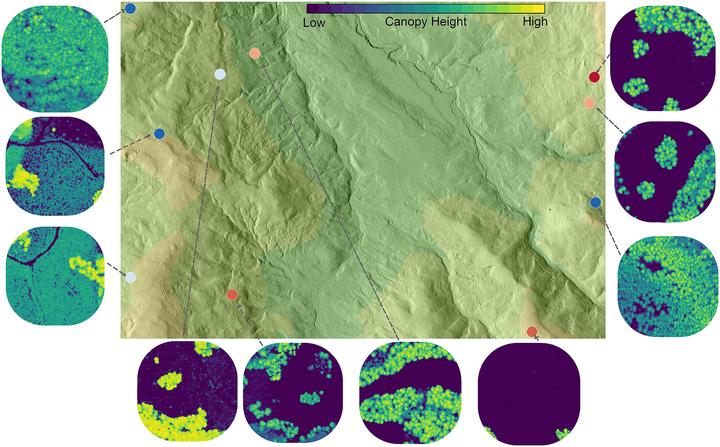Habitat–trait interactions that control response to climate change: North American ground beetles (Carabidae)
 Title: Climate–habitat interactions at Abby Road (ABBY), north-east of Vancouver, WA. Hillshading is used to visualize local terrain in the background map. Each inset plot represents the plot-level canopy height model (CHM) from Light Detection and RAnging (LiDAR), where green and yellow colours indicate high values and purple colour represents low ones. Symbols of the points represent abundance change in Pterostichus pensylvanicus between 2081–2100 and historical baseline under climate change scenario shared socioeconomic pathways (SSP) 4.5. Blue indicates decreasing and red means increasing.
Title: Climate–habitat interactions at Abby Road (ABBY), north-east of Vancouver, WA. Hillshading is used to visualize local terrain in the background map. Each inset plot represents the plot-level canopy height model (CHM) from Light Detection and RAnging (LiDAR), where green and yellow colours indicate high values and purple colour represents low ones. Symbols of the points represent abundance change in Pterostichus pensylvanicus between 2081–2100 and historical baseline under climate change scenario shared socioeconomic pathways (SSP) 4.5. Blue indicates decreasing and red means increasing.
Abstract
As one of the most diverse and economically important families on Earth, ground beetles (Carabidae) are viewed as a key barometer of climate change. Recent meta-analyses provide equivocal evidence on abundance changes of terrestrial insects. Generalizations from traits (e.g., body size, diets, flights) provide insights into understanding community responses, but syntheses for the diverse Carabidae have not yet emerged. We aim to determine how habitat and trait syndromes mediate risks from contemporary and future climate change on the Carabidae community. We synthesized the abundance and trait data for 136 species from the National Ecological Observatory Network (NEON) and additional raw data from studies across North America with remotely sensed habitat characteristics in a generalized joint attribute model. Combined Light Detection and RAnging (LiDAR) and hyperspectral imagery were used to derive habitat at a continental scale. We evaluated climate risks on the joint response of species and traits by expanding climate velocity to response velocity given habitat change. Habitat contributes more variations in species abundance and community-weighted mean traits compared to climate. Across North America, grassland fliers benefit from open habitats in hot, dry climates. By contrast, large-bodied, burrowing omnivores prefer warm-wet climates beneath closed canopies. Species-specific abundance changes predicted by the fitted model under future shared socioeconomic pathways (SSP) scenarios are controlled by climate interactions with habitat heterogeneity. For example, the mid-size, non-flier is projected to decline across much of the continent, but the magnitudes of declines are reduced or even reversed where canopies are open. Conversely, temperature dominates the response of the small, frequent flier Agonoleptus conjunctus, causing projected change to be more closely linked to regional temperature changes. Carabidae community reorganization under climate change is being governed by climate–habitat interactions (CHI). Species-specific responses to CHI are explained by trait syndromes. The fact that habitat mediates warming impacts has immediate application to critical habitat designation for carabid conservation.
Research Highlights
- Climate-habitat interactions govern Carabidae community reorganization under climate change
- Traits syndromes emerge from CHI and summarized differences in between-species response to climate change
- Habitat variable could be more important than climatic background
- Grassland fliers benefit from open habitats in hot, dry climate
- FOrest carnivores are predicted to decline under future warming